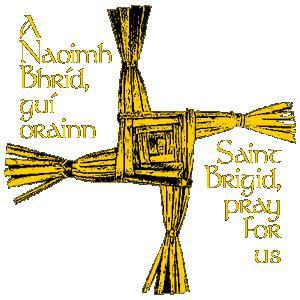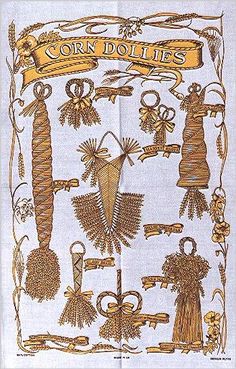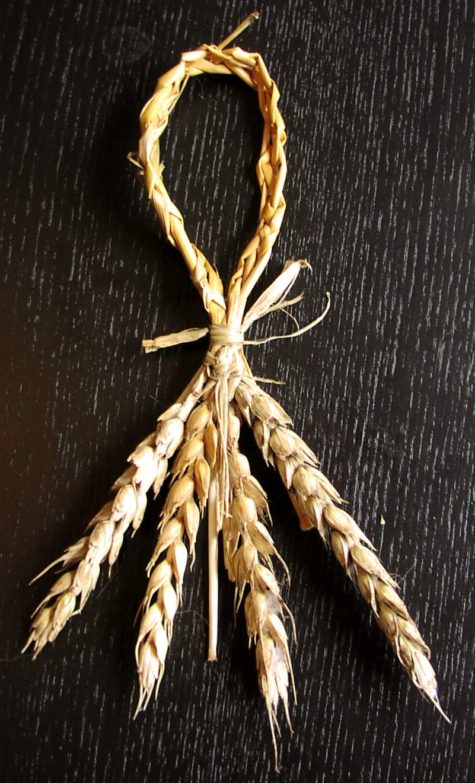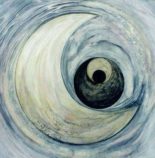Corn Dolly
Brighids Cross
 Corn dollies are frequently constructed in the shape of Brighids Cross, and although the symbol itself predates Christianity, it was given the name of the saint in order to ease the passage of acceptance of the new religion.
Corn dollies are frequently constructed in the shape of Brighids Cross, and although the symbol itself predates Christianity, it was given the name of the saint in order to ease the passage of acceptance of the new religion.
The symbol is reminiscent of the ancient Sun symbol, the swastika, its four arms pointing to the cardinal points of the compass. They also represent the Elements, with the point at the center indicating the fifth element of quintessence.
From: Encyclopedia of Secret Signs and Symbols
Corn Dolly
These days, the corn dolly generally gathers dust in gift shops, an innocuous souvenir for tourists in rural areas, particularly in the UK. However, its origins as a powerful magical symbol go back thousands of years to pre-Christian times. It may come as a surprise that the corn dolly hanging on the kitchen wall can trace its roots back to a particularly bloody ritual.
In any agrarian culture, the success of the crops is all-important and in Northern Europe the harvest produce was essential to survival during the winter period. It was the generally held belief that the spirit of the harvest – in this case, the versatile grain crop – resided in the plant, and once the plant was cut down then the spirit effectively became homeless.
In order to provide a new home for this spirit, the farmers made a corn dolly from the very last stalks of the crop. The dolly would spend her time indoors over the winter, waiting to be plowed back into the ground at the start of the new season.
In places where the corn dolly custom was not established, the last few stalks of corn were violently beaten into the ground, thus driving the spirit back into the earth.
In some districts corridors of standing corn were left from one field or plot to the next, so that the spirit would have a way of retreat till the last strip of corn was reached. The reapers would then line up before it and throw their sickles at it, so that the goddess would never know whose hand had cut the last stalks.
These were then gathered up reverently and woven into the image of the spirit or Corn Goddess, who thenceforth held a place of honor at the harvest home feast and then by the family hearth. On Plough Monday it was taken to the fields and interred in the first furrow of the new season, ready to work the necessary magic for the next harvest. “Dolly” may be a corruption of “idol” or may have come directly from the Greek word eidolon, which means apparition or that which represents something else.
 The dolly was made into a shape of an old woman, representing the Crone aspect of the Harvest Goddess. She was drenched in water as a further propitiation to the Gods and to ensure that plenty of rain would feed the harvest to come. Different areas had different styles of corn dollies.
The dolly was made into a shape of an old woman, representing the Crone aspect of the Harvest Goddess. She was drenched in water as a further propitiation to the Gods and to ensure that plenty of rain would feed the harvest to come. Different areas had different styles of corn dollies.
However, the custom of preserving the spirit of the harvest was not always carried out in such a genteel way. The Phrygians, who lived in central Asia Minor and worshiped the Mother of the Gods, Cybele, carried out a different sort of ceremony.
Their corn dolly was formed from thickly plaited sheaves of corn formed into a tall column. Any stranger found in the vicinity was captured in the belief that his presence there would mean that the spirit of the harvest had possessed his body and caused him to wander into the area. The hapless stranger was then trapped within this cage of corn and then beheaded in the belief that the blood that fell upon the ground contained the valuable “soul” of the crop.
From: The Element Encyclopedia of Secret Signs and Symbols



